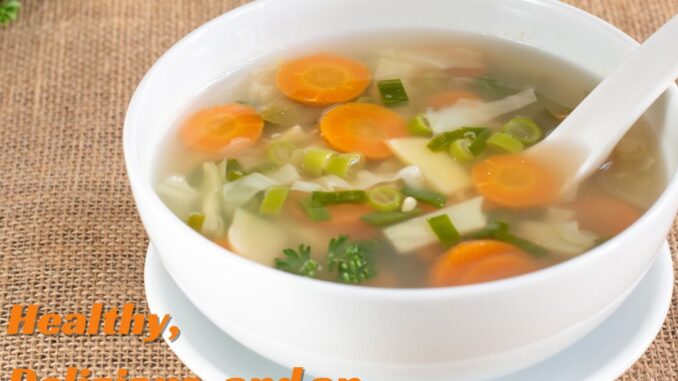
Vegetable Soup: Healthy, Delicious, and an Ultimate Comfort Food
Vegetable soup is one of the easiest nourishing dishes that could be made up with an assortment of fresh, nutrient-rich vegetables in a flavorful broth.
The best thing about vegetable soup is that it is really low in calories and rich in vitamins, minerals, and fiber-so nutritious. Anyone, one and all, can have vegetable soup since it can be varied with seasonal or popular vegetables and herbs according to budget and dietary requirements.
Here’s everything you need to know about making delectable vegetable soup, from its benefits to an easy recipe and some great tips for customization.
Health Benefits of Vegetable Soup
Besides filling you up, vegetable soup is simply very good for health:
Nutritious:
Contains loads of vitamins (such as A, C, and K) and minerals (such as potassium and magnesium) from many vegetables.
Boost the immune system:
Many of the vegetables used in soups, like carrots and bell peppers, have antioxidants that help to keep the immune system in a healthy state.
Improves Digestion:
These vegetables have fiber in them, which helps improve digestion and makes one feel full.
Low calorie:
Vegetable soup is low in calories, making it good for those who want to lose weight.
Rehydrates: The broth will help hydrate the body and give a soothing feeling to it. Basic Vegetable Soup Recipe
This is a simple, flexible, and altogether adaptable recipe. Feel free to tinker with it to your taste.
Ingredients:
1 tablespoon of olive oil or ghee
onion chopped
2-3 cloves garlic minced
1-2 carrots diced
bell pepper diced
A zucchini diced
cup green beans chopped
A cup spinach or kale chopped (optional)
tomato diced or 1 cup crushed tomatoes
4 cups vegetable broth or water
Season with salt and pepper according to taste
teaspoon dried herbs such as thyme, oregano or basil
A sprig of fresh parsley or cilantro for garnish
Instructions:
Add olive oil to large saucepan. Adds onion and garlic into the saucepan and sauté until soft and fragrant.
Add vegetables:
Adds carrots, bell pepper, zucchini, green beans, etc. Sauté for 2-3 minutes. Add broth: Add vegetable broth, tomatoes, herbs, salt and pepper. Bring to a boil.
Simmer:
Lower heat and simmer soup for 15-20 minutes or until all vegetables are tender.
Seasoning can be adjusted before serving. This vegetable soup can be dressed with fresh parsley or cilantro and served hot. Vegetable soup may be customized
Add protein:
Serve with chickpeas, lentils, or tofu for a boost of protein
Use seasonal vegetables:
With extra flavor, it is wonderful to make use of seasonal vegetables that include pumpkin, squash, and corn
Season it:
Add a pinch of chili flakes, ginger, or cumin for extra heat and spice
Creamer consistency:
For a creamier consistency without adding cream, puree half of the soup.
Bottom line
Vegetable soup is a tasty, healthy, and versatile meal that can be served as a starter, main course, or snack. It is prepared with very simple ingredients and uncomplicated preparation, making it an excellent way to consume more vegetables, stay hydrated, and acquire a few benefits from enjoying a meal that also benefits the overall well-being.
Health Benefits
Additional health benefits aside, vegetable soup is truly a versatile dish that can easily fit into virtually any meal plan and dietary style. In particular, regardless of whether you are following a vegetarian, vegan, low-carb, or gluten-free diet.
T his soup can be readily adjusted to suit your requirements. For example, low-carb enthusiasts can use vegetables like zucchini, cauliflower.
Leafy greens while avoiding starchy options like potatoes, transforming the soup into a low-carb-friendly meal.
Additionally, for those transitioning to a plant-based diet, vegetable soup offers a welcoming entry point, allowing you to experiment with new flavors and textures as you incorporate a wider variety of vegetables into your meals. Over time, you can adjust the herbs, spices, and textures to tailor the soup to your evolving taste preferences while maintaining its health benefits.
For example, using low-carb vegetables such as zucchini, cauliflower, and spinach rather than high-carb ingredients like potatoes makes vegetable soup a highly compatible choice for low-carb or ketogenic diets. And, of course, anyone on a high-protein diet can add chickpeas, lentils, or tofu to reap that added protein benefit without sacrificing the healthy, nutrient-dense profile of the soup. Want to go plant-based? Vegetable soup is the perfect way to add more vegetables into your diet and experiment with a host of new flavors and new textures. Moreover, once you get the basics, you can always play around it by tweaking your favorite herbs and spices and tailoring it to your taste and conscience.
Conclusion
Apart from being very flexible for so many dietary preferences, it is economical and eco-friendly. Since food is pricey, vegetable soup serves to be a cheap source of sustenance for you. More importantly, you can make a large pot of it by using seasonal vegetables and that allows you to pick up seasonally or on sale, so this dish ends up being cheap enough.
The soup also cuts down food waste since it makes perfect use of the leftover vegetables that may otherwise end up in the dumpsite. These you can make in huge quantities, refrigerate and freeze them, so, come any day of the week, you are a few minutes away from a quick healthy meal. Although, Vegetable soup cooked in bulk saves time and energy but also ensures that you would have your health meal just when you need it, making it easier to stick to your health goals.
Think of vegetable soup the next time you plan a meal: not only as comfort food with good and pleasing outcomes in satisfaction terms, but also as an inexpensive and commodified dish which brings nutrients, flavors, and functionality on your table.

Leave a Reply